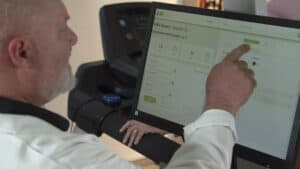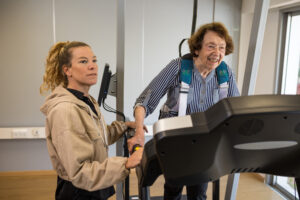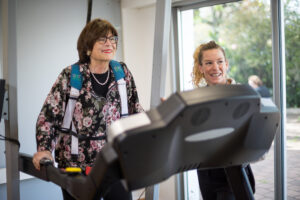
Falling is a huge issue in the older adult population. Up to 25% of older adults fall every year (Medicare Current Beneficiary Survey) and up to 6% have injuries severe enough to be seen by a medical professional (Medicare 5-percent Limited Dataset). Identifying those potential fallers provides significant upside to all parties. Senior living communities can extend average length of stay and standout among their peers. Outpatient clinics can attract new clients and maintain a strong connection to the community. And older adults get to improve their quality of life and stay healthy.
But how do you identify potential fallers? There are five categories of fall risk assessments – fall history, self-survey, gait speed, balance performance, and combined evaluations.
Option 1: Fall History / Fear of Falling
This assessment of fall risk is a single question and is currently included in the Medicare Annual Wellness Visit Questionnaire. It simply asks if you have fallen in the past year. Variations of this assessment include asking how many times you have fallen in the past year or asking if you have a fear of falling. Cutoffs for fall risk can include at least 1 fall in the past year, more than 1 fall in the past year, or are currently fearful of falling.
The basis for this assessment is the complex nature of falls and therefore the best indication of fall risk is if the person has fallen before or feels like they could fall. And there are several studies that support this approach. Asai found a 15X difference in falls between someone who had never fallen versus someone who fell at least twice in the previous 12 months (Asai, BMC Geriatrics 2022). And a meta-study found that a fear of falling seemed to increase the chance of a fall by 12X (Pena, Acta Paul Enferm 2019).
There are two issues with this approach. The first is that it can be reactive, since you are waiting for someone to fall before you identify them as a fall risk. The second is that there is often a strong correlation between experiencing a fall and fear of falling. Therefore, a person with a fear of falling has most likely fallen in the past.
Option 2: Self Survey
Self-survey tries to leverage the convenience of the fall history question while being more proactive. Like fall history, the self-survey is a questionnaire, can be done in the patient’s home (or online) and does not require a clinician.
The most common surveys are the Falls Efficacy Scale (FES) and the Activities Specific Balance Confidence (ABC) Scale. Both surveys try to gleam more insight into fear of falling, including the specific activity that could cause someone to fear falling (or losing their balance) and the intensity of that fear. By providing more of a sliding scale instead of yes/no, the surveys hope to tease out those older adults at greatest risk.
However, it suffers from the same challenges as Option 1, which is that fear of falling tends to be strongly influenced by previous falls.
Option 3: Gait Speed
This approach to fall risk requires the presence of a clinician, but it is simplest of the three types of clinical assessments. It is based on the belief that slow gait speed is a strong indicator, especially when overground gait speed drops below 1.0 meter per second (equivalent to 2.2 miles per hour). Sources that cite 1 m/s as the gold standard for predicting falls include Kyrdalen (Physiother Res Int 2019) and Middleton (J Aging Phys Act 2015).
Capturing gait speed typically involves the 10-meter walk test (10MWT) but can also be accomplished through the 2-minute walk test (2MWT) or the timed up and go (TUG). The fall risk cutoff for TUG is typically based on times greater than 12 to 13.5 seconds, but some studies suggest that TUG provides no additional insight compared to gait speed (Viccaro, J Am Geriatr Soc 2011).
More recent research suggests a reliance on 1 m/s gait speed may be inappropriate.
- A meta-analysis and three large prospective studies found that TUG did not predict risk of falls in older healthy adults (Buatois, J Am Geriatr Soc 2008)(Boulgarides, Phys Ther 2003)(Buatois, Gerontology 2006)(Barry, BMC Geriatr 2014)
- The effect of gait speed on risk of falling was not found to be significant when adjusted for additional covariates (Verghese, J Gerontol A Biol Sci Med Sci 2009)
- The influence of gait speed depends on the location of the fall, with faster gait speed increasing the risk of outdoor falls and slower gait speed increasing the risk of indoor falls [Quach, J am Geriatr Soc 2011]
- A significant number of older adults with gait speeds above the cutoff still fall (Viccaro, J Am Geriatr Soc 2011)
- Grip strength [Pham, Plos One 2023] and falls in the past year (Adam, Int J Environ Res Public Health 2021) were found to have a stronger correlation to falls than gait speed

Option 4: Balance Performance
Some believe that vestibular, or balance, plays a key role in falls and therefore balance assessments are a stronger indication of fall risk. This includes Berg Balance Score (BBS) and Five Times Sit to Stand (FTSS).
The BBS consists of 14 daily activities that require balance with the clinician evaluating the ability of the patient to perform each activity on a five-point scale. Scores below 57 are considered low risk while anything below 41 is considered medium to high risk. This corresponds with the strong jump in the positive likelihood ratio seen by Riddle, where patients with a BBS score <40 were 12 times more likely to be a faller (Riddle, Phys Ther 1999). With FTSS, the patient sits in a chair with arms folded across the chest and then stands up and sits down 5 times as quickly as possible. The cutoff for fall risk was identified was greater than 15 seconds (Buatois, J Am Geriatr Soc 2008).
One of the challenges of the BBS is that tends to be better at identifying older adults who are NOT risk of falling (Thorbahn, Phys Ther 1996) and the initial studies (Thorbahn and Shumway-Cook, Phys Ther, 1997) were retrospective and were not double-blind. More recent prospective studies (Boulgarides, Phys Ther 2003) and meta-analyses (Lima, Physiotherapy 2018)(Park, West J Nurs Res 2017) have found that BBS was not effective in identifying fall risks among healthy older adults.
There have been similar reconsiderations around FTSS. Two early studies on FTSS found that it was primarily effective in identifying multiple fallers and was unable to differentiate single fallers from nonfallers (Butaois, 2008)(Tiedemann, Age Aging 2008). More recent studies have either found low sensitivity and specificity (Intaruk, Naresuan Phayao Journal 2021) or only mild correlation when the older adult is unable to complete the FTSS (Zhang, J Aging Health 2013).
The limitation of BBS or FTSS to identify fallers is likely due to their focus on static balance. The value of static balance assessments is limited since most community-dwelling older adults fall while in motion, which involves dynamic balance. Dynamic balance can often be confused with static balance, but they are fundamentally two different physiological mechanisms. While static balance refers to the ability to maintain stability while stationary, relying heavily on sensory inputs such as proprioception and visual cues, dynamic balance involves maintaining equilibrium during movement. Dynamic balance requires more intricate coordination between sensory systems, muscular activation, and proprioceptive feedback to adapt to changing environmental conditions and body positions.
Option 5: Combined Evaluations
Finally, because there is some uncertainty as to whether gait speed or balance are a driver for falls, the Tinetti Performance Oriented Mobility Assessment (POMA) uses multiple assessments of to evaluate gait and balance (some versions have over 20 assessments!). Any issues with Options 3 (Gait) or Options 4 (Balance) would also show up here as well.
Discussion
The challenges with an accurate fall prediction tool is well known. Issues with sensitivity and specificity are so significant as to make existing assessments unable to differentiate between high and low fall risks (Park, Aging Clin Exp Res 2018). The current state of accuracy is so frustrating that there are questions around the value of utilizing a screening test any more complicated than asking about history of falls (Gates, J Rehabil Res Dev 2008). And this is before the poor construction of most studies around fall risk identification. Most studies around suffer from high risk of bias, limited population size, failure to use double-blind, poor practices with follow up, and failure to adjust for other confounding factors (Gade, BMJ Open 2021).
A review of these studies shows that these assessments tend to correlate with age and are most successful in predicting the fall risk of the highly infirmed older adult. That is, older adults with multiple co-morbidities or those with difficulties performing one of the Activities of Daily Living (ADL). And we (senior living administrators, clinicians, etc.) already know that these people are at risk of falling.
Existing assessments struggle when studies are limited to relatively healthy older adults that have not fallen. And yet this population is the most representative of independent living residents and community-dwelling clients of outpatient clinics. And this is the population that we (senior living administrators, clinicians, etc.) desperately need help differentiating non-fallers from fallers. What’s missing?
All these clinical assessments of gate and balance are failing to leverage the latest science that shows that cognitive capacity, specifically executive function, is the key driver for falls in older adults (Mirelman, PLoS One 2012). When only executive function is measured, it can repeatedly differentiate falls and non-fallers with accuracies exceeding current approaches.
Fall risk assessment must therefore include cognitive challenges to evaluate the ability to process multiple tasks while walking. This is typically done through a combination of Dual-Tasking and TUG. But, studies around the effectiveness of Dual-Tasking TUG are as muddled as the existing assessments (ugh!!). Some studies show a good correlation (Vance, Phys Ther 2015)(Tong, J Aging Phys Act 2023) while others claim no correlation at all (Shumway-Cook, Phys Ther 2000)(Menant, Ageing Res Rev 2014). So what’s going on?
Just like the current assessments, a deeper dive into Dual-Tasking and TUG reveals that existing protocols might be insufficient. Specifically, the typical challenge of counting backward by 3 or 7 does not replicate the intensity and complexity of the real-world cognitive task of walking (Lima, Braz J Phys Ther 2015).
Recommendations
How to move forward?
- The goal of any program should be to identify someone as a fall risk BEFORE they fall.
- The odds of someone over 80 having a fall is over 30%/year. Therefore, anyone over 80 should be viewed as a high risk of falls and should be placed into a proactive fall prevention program. If the program is through physical therapy, the therapist can use any of the assessments above to show risk.
- Between the ages of 65 and 80, the cutoff for fall risk should be either based on a fear of falling or utilize Dual-Tasking TUG but utilize more intense and real-world challenges through the GaitBetter system.
Conclusion
In conclusion, the challenge of identifying fall risks among older adults is a multifaceted one, with various assessment options offering insights but also facing significant limitations. The current state of fall risk assessments highlights the complexities involved, with sensitivity and specificity issues rendering many existing tools unable to effectively differentiate between high and low fall risks. Moreover, the predominant focus on physical parameters such as gait speed and balance overlook emerging research indicating the critical role of cognitive capacity, particularly executive function, in fall prediction. As such, there is a pressing need for a more holistic approach that integrates cognitive assessments alongside traditional physical evaluations to enhance the accuracy and efficacy of fall risk identification, especially among relatively healthy older adults residing independently in communities or seeking outpatient care. By embracing this comprehensive perspective, stakeholders in senior living communities and healthcare settings can better prioritize preventive interventions and ultimately improve the well-being and safety of older adults.

